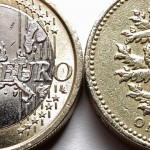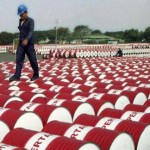Gold was steady around $1 200 on Wednesday, supported by a rebound in oil prices, but a strong dollar kept gains checked. Copper fell as worries over demand from top consumer China failed to spur bargain hunting even though prices slid to multi-year lows. Silver dipped, while platinum and palladium rose.
Comex gold for delivery in February rose 0.15% to $1 201.2 per troy ounce by 12:30 GMT, having shifted in a daily range between $1 208.0 and $1 193.5 an ounce. The precious metal fell 1.54% to $1 199.4 on Tuesday. Prices slid to a three-week low of $1 141.7 on Monday before rebounding to a five-week high of $1 221.0 an ounce.
Gold drew some support after a moderate rebound in oil prices. Crude falling by more than 30% since June and OPEC’s decision not to cut output have significantly reduced inflation expectations, curbing demand for the precious metal used as a hedge against rising prices.
A stronger dollar continued to weigh on the yellow metal. The greenback rallied to a seven-year high against the yen, with a gauge of its strength touching the highest in more than 5-1/2 years following bullish comments from US policy makers.
Federal Reserve Vice Chairman Stanley Fischer said yesterday that the Fed draws closer to dropping its vow to keep interest rates low for a “considerable time” and will emphasize on economic data guiding the interest rate hike.
“We don’t want to surprise markets,” Mr. Fischer said. “On the other hand, we can’t give precise estimates about dates that we don’t know, and that’s why the emphasis always goes back to the data, and not to the date.”
Separately, New York Fed President William C. Dudley said on Monday that nothing is certain and “judgment of the appropriate timing could change in response to incoming data and other factors that change the economic outlook”.
Both Fed officials were optimistic about the pace of US economic recovery and underlined the benefits of lower oil prices for the US economy, downplaying fears the crude price rout will push inflation too far below the 2% target.
The US dollar index for settlement in December traded at 88.875 at 12:38 GMT, up 0.19% on the day, having earlier risen to 88.960, the highest since March 2009. The US currency gauge rose 0.82% to 88.703 on Tuesday.
Investors will eye this week’s employment data from the US for further signs of robust recovery. The Labor Department is expected to report a tenth consecutive month of job growth of above 200 000 payrolls, supporting the view to raising interest rates. Market players also awaited the outcome of the ECB and BOE interest rate decisions on Thursday to gauge the strength of two of the dollar’s main trading partners.
Assets in the SPDR Gold Trust, the biggest bullion-backed ETF and a proxy for investor sentiment toward the precious metal, rose to 720.02 tons on Tuesday, the fund’s first inflow in two weeks. Nevertheless, holdings remained near the lowest in more than six years.
Copper
Copper fell for a seventh day in eight as worries of faltering demand from top consumer China weighed on speculative demand even as prices hovered near the lowest in 4-1/2 years. Mixed data from Europe also added to pressure.
Comex copper for delivery in March traded 0.59% lower at $2.8745 per pound at 12:30 GMT, having shifted in a daily range between $2.8965 and $2.8605. The contract slid 0.22% on Tuesday to $2.8915. Prices declined to $2.7650 on Monday, the lowest since June 2010, before rebounding to settle the day 1.88% higher.
The copper market remained dominated by bearish sentiment amid growing fears of a cooling Chinese economy, despite todays better-than-expected data.
The National Bureau of Statistics reported that Chinas services sector expanded at a faster pace in November compared to a month earlier, with the corresponding non-manufacturing PMI coming in at 53.9 from 53.8 in October.
A separate private report by HSBC and Markit Economics pegged the HSBC China Services PMI at 53.0, better than the expected 52.5 and above Octobers 52.9 reading, as new order intakes at service providers increased at the fastest rate since May 2012.
However, the HSBC Composite Output Index posted at 51.1, which albeit remaining above the level 50 expansion-contraction threshold, signaled a marginal rate of growth that was the weakest in six months.
Hongbin Qu, Chief Economist, China & Co-Head of Asian Economic Research at HSBC, commented: “New business improved while outstanding business contracted further. The labour market index moderated and price pressures remain subdued. The service sector saw a very marginal improvement in November, alongside sluggish activity in the manufacturing sector.”
Mr. Qu added that the PBOCs recent interest rate cut should help stabilize demand but further monetary and fiscal easing will be required.
Europe worries
Meanwhile in Europe, service activity in Italy and the UK expanded at a faster pace than expected last month, while growth in Spain slowed and France showed a larger contraction from a month earlier. Germany met expectations, while the Eurozone as a whole saw its service sector expand slower than projected, while retail sales rose more than forecast in October on an annual basis. However, downbeat numbers from Europe earlier this week, including a contraction in Germanys factory output, continued to haunt the market.
Providing some support were rumors that the People’s Bank of China might introduce additional stimulus measures, according to Reuters, including a reduction in banks’ minimum reserve requirements.
Joel Crane, an analyst at Morgan Stanley, said for CNBC: “In general, things remain OK. Globally monetary policy is still accommodative, China is going to be more accommodative, so 2015 will look better … But I cant imagine a whole lot of positivity until weve got Christmas behind us.”





